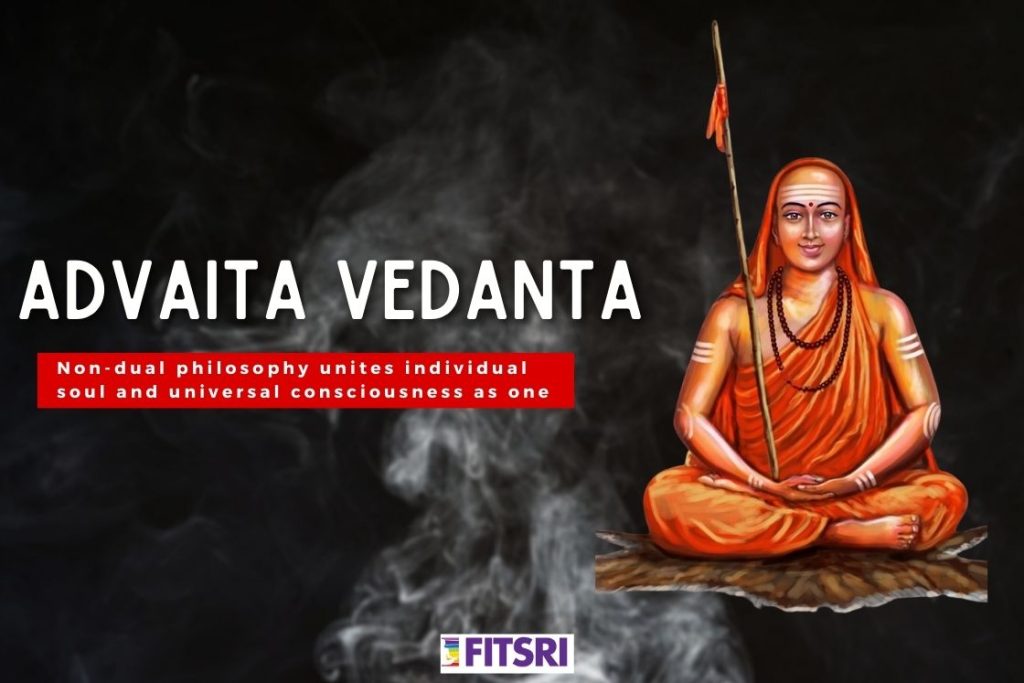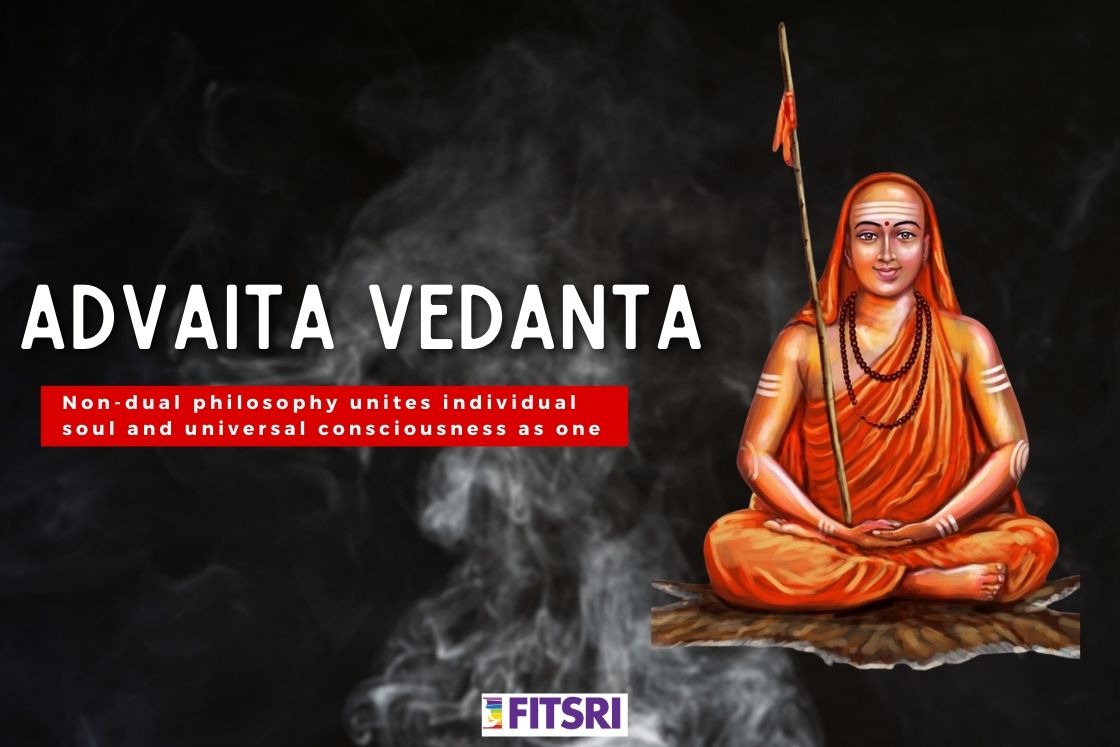
Advaita Vedanta, a phrase which will appear sophisticated, has its roots deep embedded within the religious traditions of India. Going again 1000’s of years, this philosophy comes from the traditional Vedic scriptures, supply deep insights into the character of existence. It didn’t come up instantly, however developed steadily, drawing on varied religious and philosophical texts..
Fundamental Tenets of Advaita Vedanta
Understanding Advaita Vedanta turns into less complicated if we break it down:
- Advaita: Derived from Sanskrit, “Advaita” means “not-two” or “non-dual.” At its coronary heart, this idea posits that there’s no distinction between the person soul and the common consciousness.
- Vedanta: This interprets to “the tip of data.” It signifies the last word information and understanding that one can attain, significantly referring to the character of self and the universe.
Collectively, the core precept of Advaita Vedanta states that there’s just one final actuality, and it’s the identical inside every one among us. The sense of individuality or separation we really feel is because of our restricted perceptions.
Adi Shankaracharya is a Key Determine in Advaita Vedanta
When speaking about Advaita Vedanta, it’s unattainable to miss Adi Shankaracharya. Born within the early eighth century, he was greater than a thinker; he was a religious dynamo who revitalized and redefined Advaita Vedanta. His teachings emphasised that the last word actuality or consciousness (also known as Brahman in Indian philosophy) is singular, and the soul (or Atman) is just not totally different from it. Adi Shankaracharya’s interpretations, commentaries, and writings are nonetheless studied broadly, and his influence is felt not simply in India, however throughout the globe.
With this transient introduction, we’ve scratched the floor of the deep properly of knowledge that’s Advaita Vedanta. Whether or not you’re on a religious journey or simply intrigued by philosophy, understanding this college of thought can supply profound insights into life and existence.
The Core Rules of Advaita Vedanta
The core ideas, although profound, supply a roadmap to understanding ourselves and the universe from the attitude of Advaita Vedanta. Every precept nudges us nearer to recognizing the simplicity and unity within the complicated world round us.
Non-dualism (Advaita)
On the very coronary heart of Advaita Vedanta lies the precept of non-dualism, which is basically what the time period “Advaita” stands for. It’s the concept there’s no division or duality within the basic nature of the universe. In less complicated phrases, all the things and everybody shares the identical essence, a unified, singular actuality. We would see totally different kinds, beings, and objects, however beneath the floor, it’s all one interconnected actuality.
Brahman (The Common Soul)
Brahman is a core idea in Advaita Vedanta. Consider it as the last word power or vitality within the universe. It’s formless, boundless, and everlasting. However don’t mistake it for a deity or a god within the conventional sense. Brahman is past names, kinds, and descriptions. It’s the underlying essence or basis of all the things. Once we discuss concerning the universe’s grand design or the supply of all existence, we’re basically speaking about Brahman.
Atman (The Particular person Soul)
Every one among us has a core, an inside self, also known as the soul or Atman in Advaita Vedanta. Right here’s the fascinating half: this Atman is just not totally different from Brahman. Our particular person essence or soul is a direct reflection of that common vitality. The emotions of separateness or individuality are resulting from restricted perceptions. Once we actually acknowledge our inside self, we notice we’re a part of the grand, unified actuality.
Maya (Phantasm)
Why can we really feel separated or distinct from the remainder of the universe if, on the core, it’s all one? The reply in Advaita Vedanta is Maya. Maya is the veil of phantasm that makes us understand variety and differentiation. It’s like a filter that colours our notion of the world, main us to misconceive the true non-dual nature of existence. Overcoming this phantasm is a central theme in Advaita Vedanta.
Moksha (Liberation)
Moksha could be seen as the last word purpose in Advaita Vedanta. It’s the state of liberation or freedom from the cycle of delivery and loss of life, and extra importantly, from the grasp of Maya. Attaining Moksha means recognizing the oneness of Atman and Brahman, breaking free from all illusions, and experiencing the profound interconnectedness of all existence. It’s a realization of 1’s true nature and the fruits of the Advaitic journey.
Scriptures and Texts of Advaita Vedanta
The theories and philosophies of Vedantic philosophy could seem overwhelming at first, however the scriptures and texts supply structured paths. Whether or not you’re looking for deep knowledge or just wish to perceive the fundamentals of Indian religious thought, these writings are the important thing to a treasure chest of data.
Upanishads
The Upanishads, also known as the religious coronary heart of the Vedas, are historical texts that delve deeply into the character of actuality and the self. They type the premise for a lot of India’s religious philosophy. These texts are a compilation of dialogues, discussions and insights that discover the nice questions of life. If you wish to grasp the essence of Indian thought on matters corresponding to existence, objective, and the universe, the Upanishads are your place to begin.
Brahma Sutras
The Brahma Sutras, also referred to as the Vedanta Sutras, function a scientific illustration of the teachings discovered within the Upanishads. Authored by the sage Badarayana, these sutras are concise aphorisms that delve into the character of Brahman, the last word actuality. They’re basically a highway map to information the seeker via the huge panorama of Vedantic thought and assist him navigate its intricacies.
Bhagavad Gita
The Bhagavad Gita, arguably probably the most well-known Indian scriptures, is a 700 verse dialogue between Prince Arjuna and the god Krishna, who serves as his charioteer. The Gita is greater than only a spiritual guide, for it offers with responsibility, righteousness, and the paths to religious realisation. It superbly combines philosophy, theology, and steerage for private progress, making it a textual content of immeasurable worth to everybody, no matter their background.
Prakarana Granthas (introductory texts)
For these taking their first steps into Vedantic philosophy, the Prakarana Granthas are a boon. These are introductory texts, simplifying complicated ideas and serving as a primer for the uninitiated. Authored by varied sages and students, together with the famend Adi Shankaracharya, these texts break down Vedantic teachings into digestible bits, making the profound knowledge accessible to all.
Advaita Vedanta’s Relation to Yoga
The intertwining of Advaita Vedanta and yoga gives a holistic strategy to self-discovery. Whereas Advaita Vedanta offers the roadmap, yoga equips us with the instruments to journey via it. Collectively, they pave the best way for a deeper understanding of existence and our place inside it.
The way it enhances yoga philosophies
Advaita Vedanta and yoga would possibly look like separate streams of thought, however they superbly dovetail into one another. On the core, each concentrate on the understanding and realization of the true nature of the self. Whereas yoga is commonly related to bodily postures, its true essence lies in religious growth, aligning seamlessly with the ideas of Advaita Vedanta. Yoga gives sensible instruments for private progress, and Advaita Vedanta offers the philosophical spine. Collectively, they information seekers in direction of a unified understanding of self and the universe.
Practices aligned with Advaita ideas
In yoga, sure practices resonate deeply with the teachings of Advaita Vedanta. Probably the most notable amongst these is meditation centered on self-realization. Moderately than merely being a rest software, this type of meditation pushes one to peel again layers of notion, reaching the core essence of the self. The observe aids in dissolving the phantasm of separateness (Maya), resulting in the conclusion that the person soul (Atman) and the common consciousness (Brahman) are one. Breath management (pranayama) and moral dwelling (yama and niyama) are different yoga practices that bolster the journey of understanding and embodying Advaita Vedanta’s ideas.
Advaita Vedanta in Fashionable Instances
The traditional philosophy of Advaita Vedanta stays as related and important right now because it was millennia in the past. Its modern torchbearers, coupled with a common message, be certain that its gentle continues to information, encourage, and uplift souls in our fashionable world.
Modern Lecturers and Teachings
The timeless knowledge of Advaita Vedanta continues to encourage and information, with modern lecturers respiration new life into the traditional teachings. Personalities like Ramana Maharshi and Swami Vivekananda, whereas not precisely fashionable, paved the best way for right now and made Advaita Vedanta accessible past India’s borders. As we speak, lecturers like Mooji, Rupert Spira, and Adyashanti convey contemporary views to those teachings and be certain that they resonate with the fashionable thoughts. These luminaries supply retreats, write books, and maintain classes world wide, making certain that the spirit of Advaita Vedanta stays alive.
The Relevance of Advaita Vedanta within the Fashionable World
In a world of distractions and complexity, the simplicity and directness of Advaita Vedanta supply a refuge. Its core message – the interconnectedness of all the things and the innate divinity inside every of us – gives consolation and readability. In an age grappling with individualism, materialism, and disconnectedness, Advaita Vedanta encourages introspection, unity, and true self-understanding. Its emphasis on self-realisation as the trail to contentment contrasts with fashionable notions that exterior achievements are the first sources of happiness.
The International Enchantment and Unfold of its Teachings
Advaita Vedanta’s common message of non-duality and inside peace transcends cultural and geographical boundaries. The teachings of Advaita Vedanta have discovered worldwide enchantment, and research teams, retreats, and establishments devoted to Advaita Vedanta are flourishing in varied corners of the world. The universality of its ideas–the pursuit of true self-knowledge and the conclusion of Oneness–appeals to the center and makes it engaging to numerous populations. Whether or not in bustling metropolises or quiet rural areas, the voice of Advaita Vedanta finds keen listeners.
Sensible Purposes of Advaita Vedanta
Embracing the ideas of Advaita Vedanta doesn’t require a whole overhaul of your life. With gradual steps, constant observe, and real intent, the profound knowledge of non-duality can illuminate each nook of your each day existence.
Methods to Apply Advaita Vedanta Rules in Every day Life:
The teachings of Advaita Vedanta, whereas profound, are usually not simply theoretical musings however are rooted within the practicalities of dwelling a satisfying life. Right here’s how one can incorporate its ideas each day:
- Consciousness: Frequently pause and be current. Within the midst of a busy day, taking a second to easily concentrate on your environment and inside state is usually a step in direction of recognizing the interconnectedness of all issues.
- Non-Judgment: Strategy conditions and folks with out preconceived notions. This aligns with the concept of seeing the common essence (Brahman) in everybody and all the things.
- Simplicity: Reduce pointless muddle, each materially and mentally. This will help in perceiving actuality with out the distortions of Maya (phantasm).
- Inside Reflection: Dedicate time each day for self-reflection, questioning the character of your true self, and distinguishing between the ego and the Atman.
Methods and Practices for Self-Realization
To actually perceive and embody the teachings of Advaita Vedanta, sure practices can function guiding lights:
- Meditation: Begin with a easy mindfulness meditation, focusing in your breath. Step by step, transition to self-inquiry meditation, the place you ponder questions like “Who am I?” to delve into the character of your true self.
- Studying & Contemplation: Dive into core texts just like the Upanishads or works by fashionable Advaita lecturers. However don’t simply learn—replicate deeply on their teachings.
- Satsang: Attend gatherings or classes with educated lecturers or like-minded seekers. This shared pursuit can supply readability and reinforce your understanding.
- Moral Dwelling: Align your actions with the precept of seeing the divine in all. This could imply practising kindness, honesty, and non-violence in ideas, phrases, and deeds.
Conclusion
Advaita Vedanta, at its core, delves into the profound fact of non-duality, asserting that every one of existence is interconnected. This age-old philosophy, originating from India’s sacred texts, resonates deeply even right now. It gives readability amidst the chaos of contemporary dwelling, emphasizing the innate divinity inside every of us and the interconnectedness of all issues.
In a world typically marked by divisions and distractions, Advaita Vedanta stands as a beacon, guiding seekers in direction of unity, understanding, and inside peace. Its teachings are usually not confined to scriptures however are immensely sensible, offering instruments for self-reflection, self-realization, and real contentment.
In sum, Advaita Vedanta’s significance can’t be overstated. It bridges historical knowledge and modern challenges, offering a timeless roadmap for anybody searching for deeper which means, objective, and connection of their lives. Whether or not you’re a religious seeker or just somebody searching for grounding in right now’s world, the ideas of Advaita Vedanta supply a basis of tolerating worth.
Often Requested Questions associated to Advaita Vedanta
1. Who’s God in Advaita Vedanta?
In Advaita Vedanta, God is known as “Brahman.” Brahman is the last word, unchanging actuality, amidst and past the world. It’s not a deity within the typical sense however reasonably the supreme consciousness or common precept that underlies all the things.
2. What’s the distinction between Vedanta and Advaita Vedanta?
“Vedanta” is a time period derived from “Veda-anta” (the tip of the Vedas) and refers back to the Upanishads, which expound on the philosophical teachings of the Vedas. Vedanta has a number of sub-schools, every decoding these teachings in another way. “Advaita” Vedanta, with “Advaita” which means non-dual, is one among these sub-schools. It emphasizes non-duality, suggesting that the person soul and the common soul are one.
3. Who based Advaita Vedanta?
Whereas the roots of Advaita Vedanta could be traced again to the Upanishads, Adi Shankaracharya (typically merely known as Shankara) within the early eighth century CE is credited with consolidating and systematizing its teachings. He’s typically considered the founder or key propagator of Advaita Vedanta.
4. Who’s Shiva in response to Advaita?
In Advaita Vedanta, Shiva is taken into account a illustration of the Supreme Brahman. He symbolizes the consciousness that pervades all the things. Whereas conventional spiritual practices could worship Shiva as a deity, in Advaita philosophy, Shiva is a manifestation of the last word actuality or consciousness.
5. Is Bhagavad Gita based mostly on Advaita Vedanta?
The Bhagavad Gita encompasses varied philosophical teachings, and totally different sections could be interpreted consistent with totally different Vedantic sub-schools. Advaita Vedantins see the Bhagavad Gita as supporting their view, particularly in chapters the place the oneness of the self with the last word actuality is emphasised. Nonetheless, the Gita is just not completely an Advaita textual content, because it additionally incorporates parts that resonate with different Vedantic faculties.
6. Who’re the 5 lecturers of Advaita Vedanta?
Whereas there have been quite a few lecturers and proponents of Advaita Vedanta, the custom typically speaks of a lineage of principal lecturers, generally known as the Dashanami Sampradaya. Amongst them, 5 are significantly revered:
- Adi Shankaracharya: The first consolidator of Advaita Vedanta.
- Padmapadacharya: A direct disciple of Shankara and creator of a number of vital texts.
- Sureśvarāchārya: One other pivotal disciple of Shankara identified for his works defending Advaita.
- Hastamalakacharya: Additionally a disciple of Shankara, identified for his readability on the teachings.
- Totakacharya: A famend disciple of Shankara who composed influential verses on Advaita.
7. What are the three ranges of actuality in Advaita Vedanta?
Advaita Vedanta describes three ranges of actuality:
- Paramārthika Satyam (Absolute Actuality): That is the best degree of actuality, representing Brahman or the last word fact that’s unchanging and everlasting.
- Vyāvahārika Satyam (Empirical Actuality): That is the extent of actuality we understand in our each day lives – the world, folks, objects. It’s thought-about actual however is topic to vary and thus is just not absolutely the actuality.
- Prātibhāsika Satyam (Obvious Actuality): This represents illusory or subjective actuality, like desires or hallucinations.


